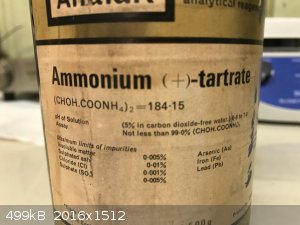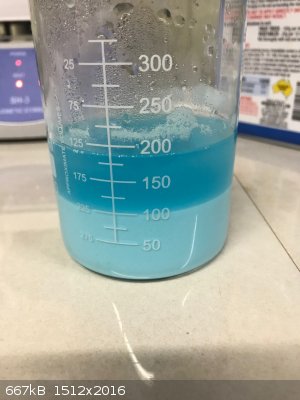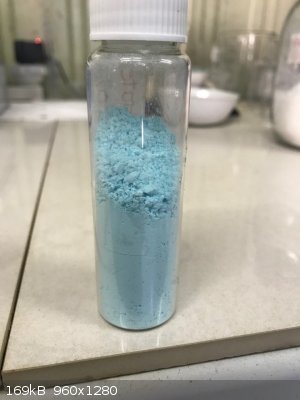nlegaux
Hazard to Self
 
Posts: 93
Registered: 28-11-2014
Location: East Tennessee
Member Is Offline
Mood: No Mood
|
|
Copper Tartrate
I haven't been able to find any (useful) information on Copper Tartrate. The only information I could find was on the wikipedia page about Tartaric
acid (http://en.wikipedia.org/wiki/Tartaric_acid), where it mentions that tartaric acid forms a complex with copper. Does anyone have any good
information on this complex?
Out of curiosity, I added Potassium Bitartrate to a CuSO4 solution (excess of CuSO4). The solution turned a pale blue color. When IPA was added, a
pale blue non-crystalline precipitate formed. Is this Copper Tartrate?
Thank you,
nlegaux
|
|
|
Metacelsus
International Hazard
    
Posts: 2539
Registered: 26-12-2012
Location: Boston, MA
Member Is Offline
Mood: Double, double, toil and trouble
|
|
Tartaric acid and copper are used in the biuret reagent; tartaric acid and copper definitely form a complex. Copper tartrate should be isolable, but
I'd prepare it by directly reacting tartaric acid with copper hydroxide.
|
|
|
Amos
International Hazard
    
Posts: 1406
Registered: 25-3-2014
Location: Yes
Member Is Offline
Mood: No
|
|
I have made a deep blue complex, similar to the tetraammine copper(II) complex but without any hint of violet coloration, by adding potassium/sodium
tartrate to a solution of copper(II) sulfate and heating. The tartrate I believe was produced by adding sodium carbonate to an excess of potassium
bitartrate in solution. I wish I had kept some notes on that...
|
|
|
Paddywhacker
Hazard to Others
  
Posts: 478
Registered: 28-2-2009
Member Is Offline
Mood: No Mood
|
|
I once made some by dissolving copper(II) oxide in aqueous tartaric acid. The two were in stociometrically equal amounts and the container was heated
in a pressure cooker for 30 minutes.
All of the black oxide dissolved to give a pale blue precipitate that was soluble in excess potassium hydrogen tartrate solution. Somebody suggested
that I had the basic tartrate salt, but I don't believe that. So the straight salt was only sparingly soluble, but it dissolved in excess tartrate to
form the usual complex. The complex should have also been stable to alkali, but I didn't test for that.
A similar experiment with citric acid was similar, but not all of the copper oxide dissolved.
|
|
|
nezza
Hazard to Others
  
Posts: 324
Registered: 17-4-2011
Location: UK
Member Is Offline
Mood: phosphorescent
|
|
Copper sulphate and Sodium potassium tartrate (Rochelle salt) form the basis of Fehlings solution which is a classic test for reducing sugars. The
mixture is boiled and copper(I) oxide is formed as a yellow/red precipitate. The tartrate keeps the copper ions in solution in an alkaline solution by
complexing with the copper.
|
|
|
Dr Corvin Ravenden
Harmless

Posts: 1
Registered: 13-9-2018
Member Is Offline
|
|
The easiest way of preparing a crude solution of cupric (copper II) tartrate is to use the old technique used by ancient alchemists in order to clean
copper coins.
First boil a concentrated solution (verging on a suspension) of Cream of Tartar (Potassium Tartrate) and then throw in a load of old copper coins
whose surface will be coated with a variety of impurities (these are of minor significance) including cupric oxide which will rapidly be dissolved
into aqueous solution as a copper (II)-tartrate complex. As time goes by you will observe a) the surface of the coins becoming visibly cleaner and
shiny and eventually the solution will turn to a pale blue-green colour demonstrating the presence of copper (II) hexa-aqua complex ions and one
assumes in some sort of association with tartrate.
This is a good method for a quick result normally within 30 minutes as it avoids the use of using copper (II) sulphate that however lovely Blue
Vitriol is, it tends to mask the colour of the tartrate that is less soluble than the sulphate, hence boiling the coins in an old Teflon coated plan.
Copper coins also substitute for normal cupric oxide that can be difficult to find and purchase in some countries.
|
|
|
fusso
International Hazard
    
Posts: 1922
Registered: 23-6-2017
Location: 4 ∥ universes ahead of you
Member Is Offline
|
|
Quote: Originally posted by Dr Corvin Ravenden  | The easiest way of preparing a crude solution of cupric (copper II) tartrate is to use the old technique used by ancient alchemists in order to clean
copper coins.
First boil a concentrated solution (verging on a suspension) of Cream of Tartar (Potassium Tartrate) and then throw in a load of old copper coins
whose surface will be coated with a variety of impurities (these are of minor significance) including cupric oxide which will rapidly be dissolved
into aqueous solution as a copper (II)-tartrate complex. As time goes by you will observe a) the surface of the coins becoming visibly cleaner and
shiny and eventually the solution will turn to a pale blue-green colour demonstrating the presence of copper (II) hexa-aqua complex ions and one
assumes in some sort of association with tartrate.
This is a good method for a quick result normally within 30 minutes as it avoids the use of using copper (II) sulphate that however lovely Blue
Vitriol is, it tends to mask the colour of the tartrate that is less soluble than the sulphate, hence boiling the coins in an old Teflon coated plan.
Copper coins also substitute for normal cupric oxide that can be difficult to find and purchase in some countries. |
What kind of countries would CuO be difficult to find? I don't think CuO could be used to make any drugs or explosives.
|
|
|
Jackson
Hazard to Others
  
Posts: 189
Registered: 22-5-2018
Location: U S of A
Member Is Offline
Mood:  Happy about new glassware 
|
|
nlegaux, you said you added IPA to the solution which cause a precipitate. Did the IPA cause the precipitation? Does IPA precipitate all copper salts?
|
|
|
DraconicAcid
International Hazard
    
Posts: 4333
Registered: 1-2-2013
Location: The tiniest college campus ever....
Member Is Offline
Mood: Semi-victorious.
|
|
Quote: Originally posted by Jackson  | | nlegaux, you said you added IPA to the solution which cause a precipitate. Did the IPA cause the precipitation? Does IPA precipitate all copper salts?
|
Adding an alcohol to an aqueous solution will reduce the solubility of all ionic compounds.
Please remember: "Filtrate" is not a verb.
Write up your lab reports the way your instructor wants them, not the way your ex-instructor wants them.
|
|
|
Lion850
National Hazard
   
Posts: 517
Registered: 7-10-2019
Location: Australia
Member Is Offline
Mood: Great
|
|
I recently acquired a bottle of old ammonium tartrate. Photo below. The lid was broken, but the contents was dry and looks like small glittering
crystals - it reminded me of sugar. It did not have any ammonia smell which surprised me but adding a bit to a strong sodium hydroxide solution
produces lots of ammonia gas so it seemed good. It was transferred to a different jar and I decided to have a go at making copper tartrate by double
displacement:
(NH4)2C4H4O6 + CuSO4 = C4H4CuO6 + (NH4)2SO4
- 20g of copper sulphate pentahydrate was dissolved in 110g water in a beaker; it was heated to near boiling speed up the dissolving.
- 16g of ammonium tartrate was dissolved in 50g water; also heated to get a clear solution. This should have put the ammonium tartrate in slight
excess.
- Solutions were mixed while still warm and hand-stirred for 10 minutes.
- Result was a pale blue ppt with a darker blue supernatant liquid. See photo. I wondered if the blue supernatant liquid was due to unreacted copper
sulphate, and to check I decanted off the blue liquid and mixed it with more ammonium tartrate: there was no color change and no ppt showing that
there was most likely no copper sulphate left.
- The contents was vacuum filtered and the light blue remainder dried on a steam bath until the weight stopped dropping. The drying did not change the
color. See photo of the final product in the vial.
- Final dry product was 15.6g.
I found a few photos online of copper tartrate and it is the same color.
Why was the supernatant liquid blue after the double displacement? Online some sites says copper tartrate is very slightly soluble in water, which may
be the reason. Or did the slight excess ammoinium tartrate form a soluble complex with a bit of the copper? I'll shake some up with water when next in
the shed to see if it makes a blue solution.
  
|
|
|